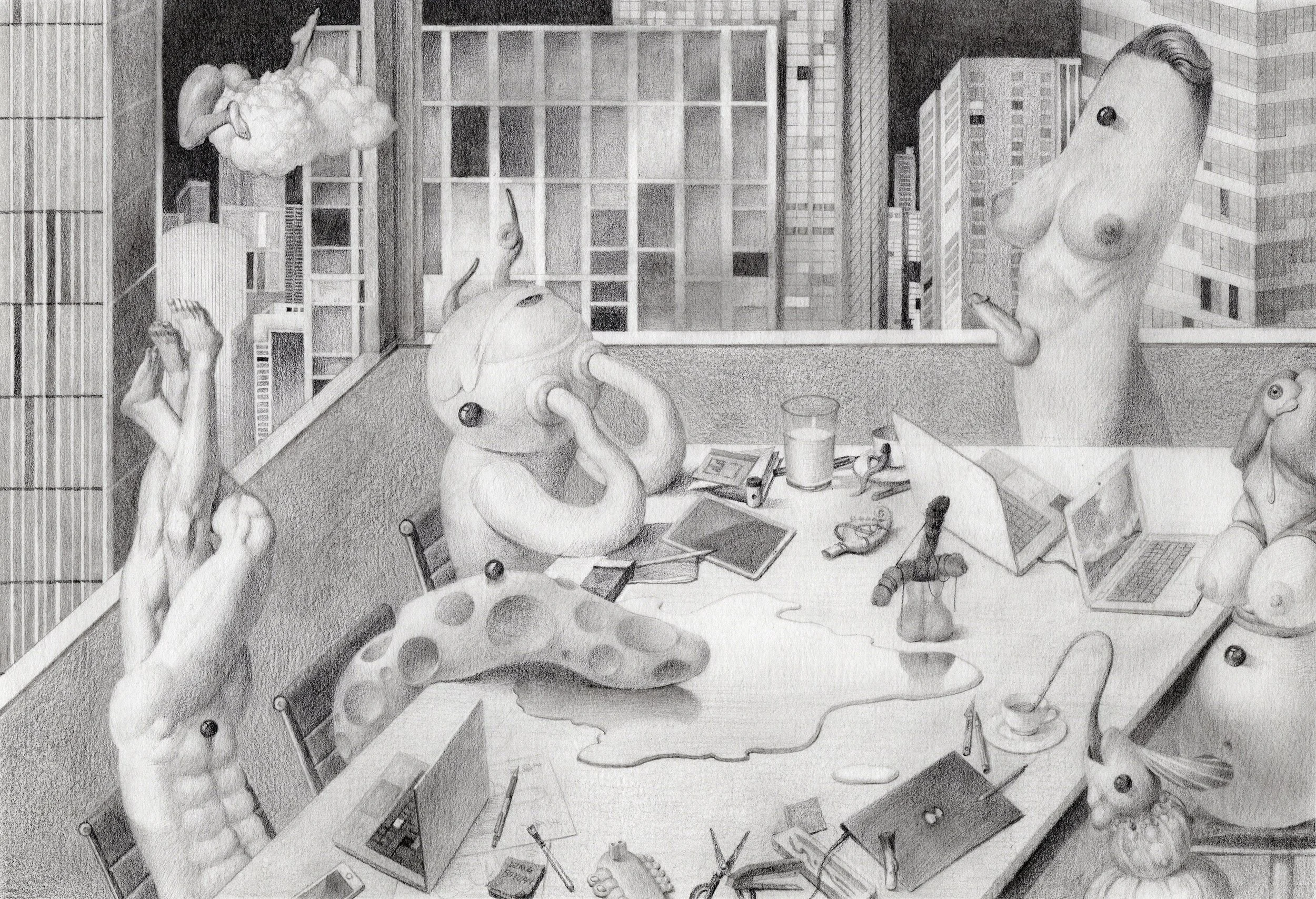10 Questions with Daniel Selyebi
Dani Selyebi was born on February 9, 1995 in Budapest. After graduating from high school, he participated in a two-year graphic design course from 2016 to 2018, where he already felt that illustration was the closest to him. After that, he self-taught and developed himself, where he experimented a lot with figurative abstract ink drawings. He also got a taste of the tattooing profession from 2018 to 2019 but soon realized that he could not connect to this. In 2021, he started working on commissions as a freelancer, where he painted numerous small-scale ink drawings and paintings in his distinctive figurative abstract style but also created label designs as well as book and verse illustrations. In 2023, he began experimenting with larger and larger canvas paintings, and since then, he has created several series.
Daniel Selyebi - Portrait
In 2022, he created the cover design and illustrations for his new book of poems for Imre Lutter (president of the Association of Hungarian Poets). The same year, he also participated in the three-week residency program of Budapest Hybridcycle. (Clean Balaton). In 2022, he also participated in several nature-themed group exhibitions of the hybridart pop-up gallery, and he held his first solo exhibition (Balance), which was shown at the Easy Art Space in Budapest.
From 2023, his plans took a new direction; he is currently working on expanding his portfolio in order to present his larger paintings through galleries.
Dani is mostly inspired by the balance and primal trust felt in nature by experiencing the state of the here and now. This has become more important to him than any philosophy. He wants to express the dynamism of pure and thoughtless moments while maintaining this powerful state.
He tries to keep in mind a kind of dynamic flow where every point and line serves to guide the eye. He creates according to the principle of less is more, maintaining the characteristic airy character of his figures, which sometimes border on abstraction.
Daniel Selyebi’s Studio
INTERVIEW
Can you share how your journey as an artist began? Were there specific moments or experiences in your early life that set you on this path?
As a child, I spent a lot of time drawing, but over the years, it faded into the background. After finishing high school, I had no real idea of where to continue my studies, and I eventually ended up in a graphic design program. I quickly grew fond of it—childhood memories came rushing back. It felt good to retreat into my own world; I often stayed in the studio after class in the afternoons, studying sculptures.
At the time, I wasn't in a good state. I struggled with intense anxiety, and in the beginning, creating art served as a kind of therapy for me. I soon realized that I should have given myself this opportunity much earlier. Looking back, that was probably the most defining period of my life. It suddenly became clear how much this meant to me—it gave me new goals, both professionally and in terms of finding a better mental state.
In your journey, you explored graphic design, tattooing, and illustration. How did these experiences shape your unique style?
In the early days, I made countless sketches. I carried a sketchbook with me everywhere, and it quickly filled up with abstract gestures and dynamic striggles. I experimented a lot with textures, and over time, they began to evolve—becoming more refined, sometimes even pushing the boundaries of figuration.
At the same time, I was designing a lot of logos, which taught me the principle of "less is more." I feel that these two contrasting approaches have shaped the way I see things today. I try to keep them in balance and incorporate both into my design work.
Tattooing came later, as a brief detour. My work didn't translate as well onto skin—tattoo design requires a highly conscious approach to align with the body's natural flow, and I couldn't quite achieve that with my graphic style.
© Daniel Selyebi
Speaking of your style, what are the main influences that helped you develop it? Do you have any artist, school, or movement you particularly look up to?
I'm not exactly sure what my main influence was. When I started all of this, I spent a lot of time looking inward. I was almost always alone, often out in nature. It was mainly the atmosphere I experienced there that touched me—I kept returning to that feeling.
I had a few wonderful teachers in my graphic design course who motivated me, but beyond them, I didn't really know other artists or schools. I isolated myself a bit during that time. I also started working on trauma release, which brought years of difficult emotional states. Looking back now, seeing the parallel between my personal healing and the unfolding of my painting, I believe that these inner processes had the greatest impact on me.
Nature and the concept of balance seem central to your work. How did these themes become such a significant influence in your art?
I spent a lot of time in solitude outdoors. I am deeply moved by the harmony I sense there—it makes me feel that everything is connected in a vast, natural cycle. I am drawn to the experience of this underlying primal trust.
Perhaps that's why the animal world is a central theme in my painting—it serves as a perfectly grounded channel for this state of being. Animals embody the raw dynamism behind my thoughts and the instinctive nature of movement.
Your works often embody a "less is more" principle with an airy, dynamic flow. Can you walk us through your creative process? How do you achieve this balance between simplicity and complexity?
I keep three main aspects in mind: flow, character, and the principle of less is more.
I use every mark and stroke as a mass to guide the eye, creating a continuous flow within the painting. Balancing this with a stylized figure, however, isn't always easy. Sometimes, I have to add more details to emphasize the airy character of the piece, but if I'm not careful, it can easily disrupt the balance. Even the smallest detail has to serve the whole—one slightly stronger line can draw too much attention and break the flow, making the painting feel stuck.
I often find myself hitting a dead end, forcing me to rethink my approach. I try to map out a path through this sea of lines and shapes, but this usually happens organically during the process. A large part of my work consists of just staring at the canvas for minutes and only then making two strokes or flicking a bit of ink. And somehow, things start coming together. Sometimes, I need to set the painting aside for a while so that when I return, I can suddenly see the way forward with fresh eyes.
Mr. fox, ink, canvas, 80x120 cm, 2023 © Daniel Selyebi
Unit, ink, canvas, 140x110 cm, 2024 © Daniel Selyebi
Rite, ink, canvas, 210x160 cm, 2024 © Daniel Selyebi
Without title, ink, canvas, 105x140 cm, 2025 © Daniel Selyebi
The transition from small-scale ink drawings to large canvas paintings marks an exciting shift in your practice. What challenges or revelations have you encountered in this expansion?
The transition was interesting. I was used to designing everything hunched over a desk, but with painting, I often had to step back and look at the piece from a distance to avoid getting lost in the details. It was a difficult shift. After many unsuccessful attempts, though, something started to take shape.
I began splattering white primer over the black areas that felt too heavy. This created much more delicate abstract details and added an interesting texture to certain parts of the canvas. Over time, it became much easier to play with the balance between black and white this way.
If you could leave viewers with one feeling or thought after experiencing your art, what would that be, and why?
Give more space to feelings and think less. That way, you can connect more deeply with yourself.
You've been part of group exhibitions, a solo show, and residency programs. How have these opportunities shaped your perspective as an artist?
Each experience was truly wonderful. I had the chance to meet new people and find inspiration. One of the most exciting projects was a three-week residency program by Hungary's largest lake, Lake Balaton. This was followed by my first solo exhibition in Budapest, where it was a heartwarming feeling to see my work installed for the first time. Back then, they were large-scale prints made from my smaller graphics. Perhaps that was the moment I decided to create the originals in that size—or even larger.
Bora, ink, canvas, 170x230 cm, 2024 © Daniel Selyebi
What are your aspirations for your larger-scale paintings and the direction you'd like your artistic career to take?
I want to refine and develop my vision even further so that my artwork can function on a much larger scale. My goal is to make painting my profession. For some time now, I've been reaching out to interior design studios and decorators, and I feel they are open to my work.
I don't have much experience with galleries yet, but I do plan to submit my portfolio to places that might be receptive to my style. It's a process, and I trust that the right direction will take shape and that I will find the right people to support me along the way.
Lastly, what are your goals for 2025? Do you have anything planned or anything you particularly look forward to?
I would like to send my portfolio to smaller international galleries. It would be wonderful to take part in group exhibitions. I also hope that something meaningful will emerge from the interior design direction as well. I apply to open calls, too—that's actually how I found you. Thank you for the opportunity!
Artist’s Talk
Al-Tiba9 Interviews is a promotional platform for artists to articulate their vision and engage them with our diverse readership through a published art dialogue. The artists are interviewed by Mohamed Benhadj, the founder & curator of Al-Tiba9, to highlight their artistic careers and introduce them to the international contemporary art scene across our vast network of museums, galleries, art professionals, art dealers, collectors, and art lovers across the globe.






















